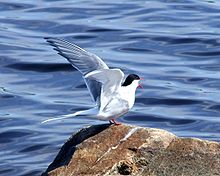MILBRIDGE — Biologists in Maine have attached tiny devices to 30 Arctic terns to learn more about their migratory routes.
Scientists with the U.S. Fish and Wildlife Service say birds on Maine’s Metinic Island and Eastern Egg Rock had devices known as “geolocators” attached to their legs last month. The biologists hope to catch the same birds next year, download the data and make maps of the migration route for each bird.
Biologists with the wildlife service’s Maine Coastal Islands National Wildlife Refuge say this is the first time the devices have been placed on Arctic terns in North America. The terns each year make a 25,000-mile round-trip between the northern and southern hemispheres.
Copy the Story LinkSend questions/comments to the editors.



Success. Please wait for the page to reload. If the page does not reload within 5 seconds, please refresh the page.
Enter your email and password to access comments.
Hi, to comment on stories you must . This profile is in addition to your subscription and website login.
Already have a commenting profile? .
Invalid username/password.
Please check your email to confirm and complete your registration.
Only subscribers are eligible to post comments. Please subscribe or login first for digital access. Here’s why.
Use the form below to reset your password. When you've submitted your account email, we will send an email with a reset code.